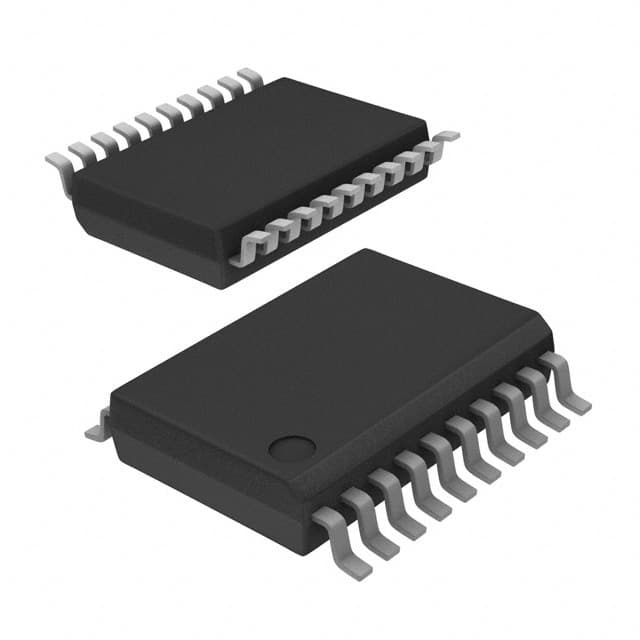Xem thông số kỹ thuật để biết chi tiết sản phẩm.

74HCT240DB,112
Basic Information Overview
- Category: Integrated Circuit (IC)
- Use: Logic Gate Buffer/Driver
- Characteristics: High-speed, CMOS technology, low power consumption
- Package: SOIC (Small Outline Integrated Circuit)
- Essence: Buffer/Driver IC for digital signal amplification and isolation
- Packaging/Quantity: Tape and Reel, 2500 pieces per reel
Specifications
- Supply Voltage Range: 2.0V to 6.0V
- Input Voltage Range: 0V to VCC
- Output Voltage Range: 0V to VCC
- Operating Temperature Range: -40°C to +125°C
- Propagation Delay Time: 10 ns (typical)
- Output Current: ±6 mA
Detailed Pin Configuration
The 74HCT240DB,112 IC has a total of 20 pins arranged as follows:
__ __
A1 | 1 20 | VCC
A2 | 2 19 | B1
A3 | 3 18 | B2
A4 | 4 17 | B3
A5 | 5 16 | B4
A6 | 6 15 | B5
A7 | 7 14 | B6
GND | 8 13 | B7
OE | 9 12 | B8
Y1 |10 11 | Y2
‾‾ ‾‾
Functional Features
- Buffer/Driver: The 74HCT240DB,112 is designed to amplify and isolate digital signals.
- High-Speed Operation: It operates at high speeds, making it suitable for applications requiring fast signal propagation.
- CMOS Technology: The IC utilizes CMOS technology, providing low power consumption and high noise immunity.
- Output Enable (OE) Pin: The OE pin allows the user to enable or disable the outputs, providing flexibility in controlling the signal flow.
Advantages and Disadvantages
Advantages: - High-speed operation enables efficient signal processing. - Low power consumption makes it suitable for battery-powered devices. - CMOS technology ensures high noise immunity. - Output enable feature provides flexibility in signal control.
Disadvantages: - Limited output current may restrict its use in certain applications requiring higher current capabilities. - Operating temperature range may not be suitable for extreme environments.
Working Principles
The 74HCT240DB,112 is a buffer/driver IC that amplifies and isolates digital signals. It operates based on CMOS technology, which allows for low power consumption and high noise immunity. The inputs are buffered and amplified before being transmitted to the outputs. The output enable pin (OE) controls the flow of signals, allowing the user to enable or disable the outputs as needed.
Detailed Application Field Plans
The 74HCT240DB,112 is commonly used in various digital systems and applications, including: 1. Microcontrollers and microprocessors 2. Data communication systems 3. Memory interfaces 4. Industrial automation 5. Consumer electronics
Detailed and Complete Alternative Models
Some alternative models that can be considered as replacements for the 74HCT240DB,112 include: 1. SN74HCT240N by Texas Instruments 2. MC74HCT240AN by ON Semiconductor 3. CD74HCT240E by Texas Instruments 4. 74HCT240D by NXP Semiconductors
These alternative models offer similar functionality and characteristics, making them suitable substitutes for the 74HCT240DB,112.
Word count: 383 words
Liệt kê 10 câu hỏi và câu trả lời thường gặp liên quan đến ứng dụng 74HCT240DB,112 trong giải pháp kỹ thuật
Sure! Here are 10 common questions and answers related to the application of 74HCT240DB,112 in technical solutions:
Q: What is the function of the 74HCT240DB,112? A: The 74HCT240DB,112 is an octal buffer/line driver with 3-state outputs. It is used for signal buffering and driving in digital circuits.
Q: What is the voltage supply range for the 74HCT240DB,112? A: The voltage supply range for the 74HCT240DB,112 is typically between 4.5V and 5.5V.
Q: How many input/output pins does the 74HCT240DB,112 have? A: The 74HCT240DB,112 has 8 input pins and 8 output pins.
Q: Can the 74HCT240DB,112 handle high-speed signals? A: Yes, the 74HCT240DB,112 is designed to handle high-speed signals with a maximum propagation delay of 11 ns.
Q: What is the maximum output current that the 74HCT240DB,112 can drive? A: The 74HCT240DB,112 can drive up to 35 mA of current per output pin.
Q: Is the 74HCT240DB,112 compatible with TTL logic levels? A: Yes, the 74HCT240DB,112 is compatible with both CMOS and TTL logic levels.
Q: Can the 74HCT240DB,112 be used as a bidirectional buffer? A: No, the 74HCT240DB,112 is unidirectional and can only be used as a buffer for one-way signal transmission.
Q: What is the purpose of the 3-state outputs in the 74HCT240DB,112? A: The 3-state outputs allow the 74HCT240DB,112 to be effectively disconnected from the bus when not in use, preventing any interference or contention.
Q: Can the 74HCT240DB,112 be cascaded to drive more than 8 outputs? A: Yes, multiple 74HCT240DB,112 chips can be cascaded together to drive a larger number of outputs.
Q: Are there any special considerations for decoupling capacitors when using the 74HCT240DB,112? A: It is recommended to place a decoupling capacitor (typically 0.1 µF) near the VCC and GND pins of the 74HCT240DB,112 to ensure stable operation and minimize noise.
Please note that the answers provided here are general and may vary depending on specific application requirements.

